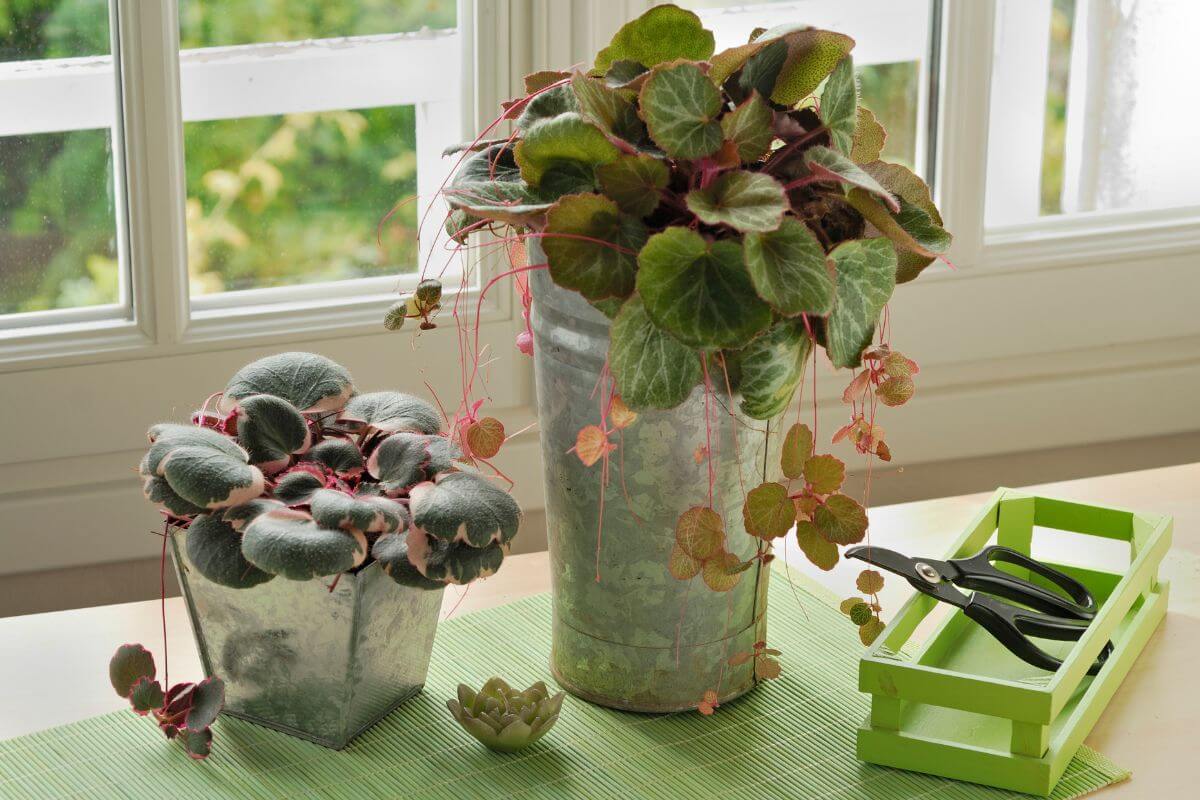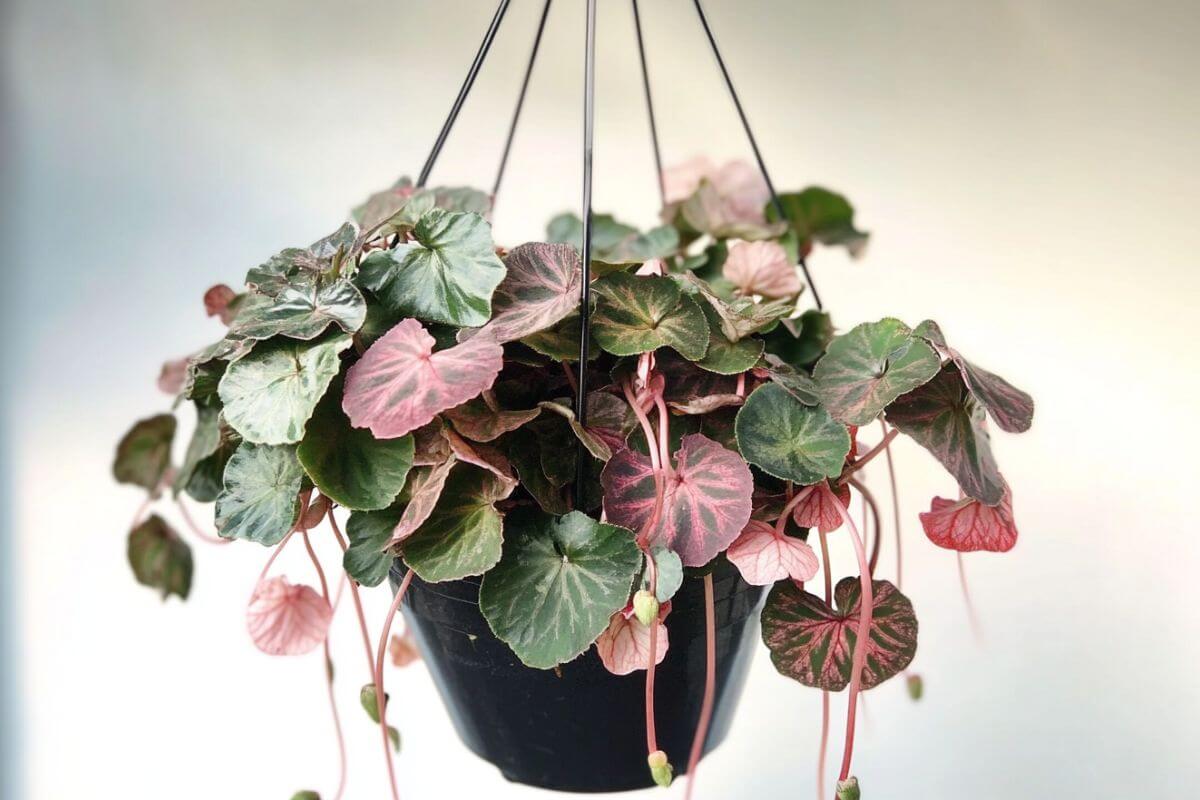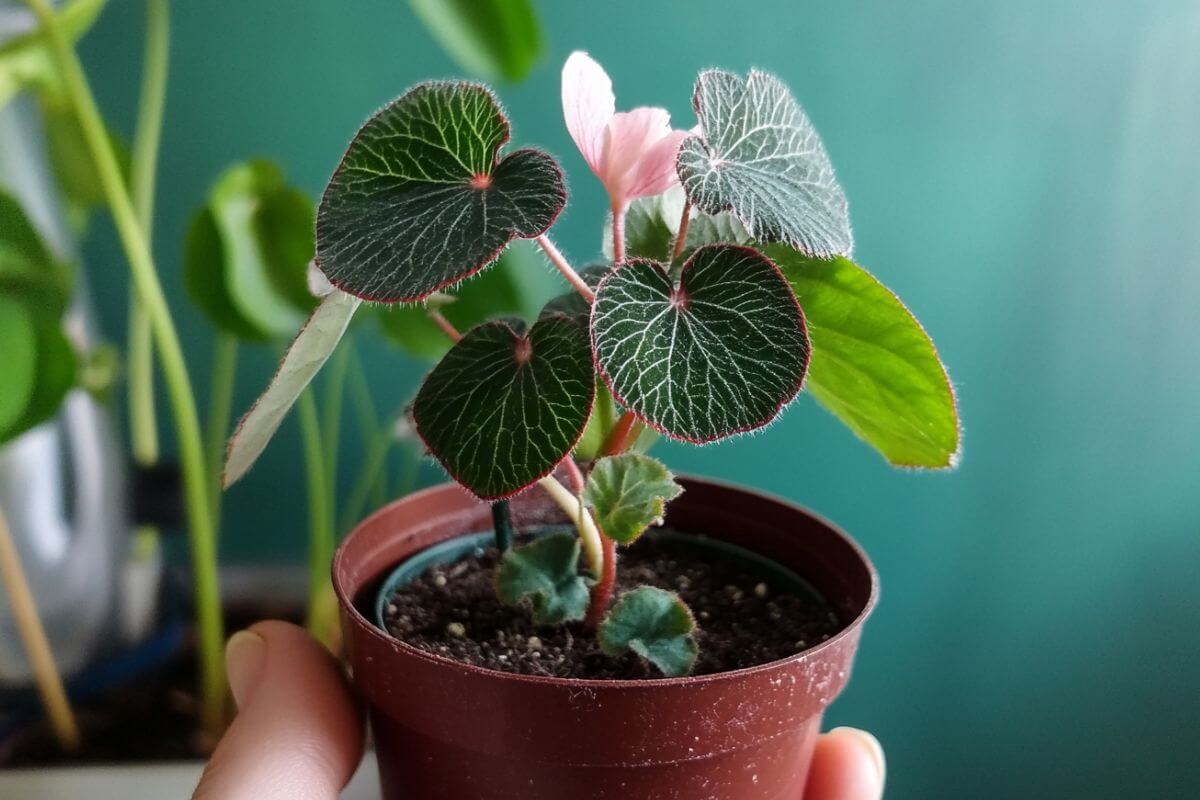While not a true begonia, the Strawberry Begonia is a delightful houseplant that features beautiful, vivid light green scalloped leaves that have silver marbling, while the undersides of leaves are hairy and deep burgundy in hue.
A small, low-growing plant, its distinguishing characteristic comes from the lengthy runners that dangle downward with plantlets attached, similar to a strawberry plant.
The runners make it a perfect plant for hanging baskets. With maturation, clusters of leaves will form at the end of the runners.
Learn how to care for and grow the strawberry begonia successfully in this guide.
Strawberry Begonia Plant Overview

Saxifraga stolonifera may seem like a mouthful, but this is actually the botanical name for the strawberry begonia, a lovely herbaceous perennial.
A native of China and Japan, the strawberry begonia can be found as a ground cover with its numerous runners taking root as they spread.
The strawberry begonia is also known as the Strawberry Geranium, the Rockfoil, and the Mother of Thousands. In its native habitat, it can be found growing between rocks in mountainous regions.
Blooms may appear during the summer months as sprays of petite creamy white flowers. Single stems may feature an inflorescence with as many as 60 flowers.
This plant can grow up to 8 inches tall, while runners can grow to 12 inches long. As the plant matures, woody stems will develop.
There are a number of strawberry begonia varieties/ The most popular strawberry begonia is the stolonifera, meaning “bearing runners.” There is also a popular variety called Tricolor, with foliage that is red and cream-colored and variegated with silver marbling.
Strawberry Begonia Plant Care Guide
Soil for the Strawberry Begonia
Standard potting soil of good quality will be adequate for strawberry begonia cultivation as long as it is well-draining. Amending potting soil with peat can assist with the drainage.
The strawberry begonia likes a soil pH level that is neutral to acidic.
These houseplants can be planted at any time of the year, so it doesn’t have to be enjoyed only in the spring and summer.
Light for the Strawberry Begonia Plant

The strawberry begonia likes bright indirect light all year round. It will appreciate a bit of direct sun limited to the mornings, but should be protected from stronger sunlight that can cause foliage to fade.
A west-facing or east-facing window would be the ideal location.
Water and Humidity for the Strawberry Begonia
The strawberry begonia should have a thorough watering, making sure that the excess water drains out of the pot’s drainage holes.
Before watering again, allow the top 2 inches of the soil bed to dry out first. There’s no need to water if it’s moist soil still.
In winter months, watering can be further reduced by about half. You run the risk of root rot, crown rot, or fungal infections if overwatered. Also, avoid getting the hairy leaves wet, as this too, can lead to fungal disease.
An average humidity level of between 40% and 50% will be fine. If your house tends to have drier air due to climate, heating, or air conditioning, use a humidifier or wet pebble tray below your plant to increase humidity levels.
Make sure that the plant’s pot does not come into contact with the water in the pebble humidity tray.
Fertilizer for the Strawberry Begonia
While not a big eater, your strawberry begonia can benefit from a monthly feeding in the spring and summer with a balanced liquid fertilizer diluted to half strength.
Temperature for the Strawberry Begonia
The strawberry begonia prefers cooler temperatures ranging between 50° and 75° Fahrenheit. It does not tolerate heat well, so the room where they are located should be well ventilated.
Even though it does not handle frost well, it still prefers cooler temperatures.
These plants can be cultivated both indoors and outdoors in USDA hardiness zones 7 through 10. Remember that because the plants have runners, they can overtake your garden. They do not appreciate any kind of extreme temperature change.
Pruning and Repotting for the Strawberry Begonia
Prune away runners every year, as they will wither and die. Also, remove or trim any offsets and yellow or dead leaves to encourage new growth of green leaves.
This is an expansive houseplant, so pruning and repotting become essential. When mature plants begin to look woody and a bit bare, your plant should be propagated and replaced.
As these plants have a short lifespan, rarely more than a few years, repotting may be unnecessary. The only exception to this will be if the plant outgrows its current container.
If you do see that these fast-growing plants are filling up its containers and the roots are poking out of the soil surface, go ahead and repot.
Propagating the Strawberry Begonia

Propagation is very easy to do when plants feature runners. There are a few different ways to propagate with runners, runner cuttings and seed.
Here is an easy propagation method with runners from the parent plant:
- Place small containers filled with moist potting soil around the mother plant.
- Leave the runners attached to the mother plant.
- Hold the runners down on the potting soil in the new containers with small pieces of wire or with paper clips.
- As soon as the baby plantlets on the runners form roots in their new containers, after approximately three weeks, you can snip the runners from the mother plant, detaching them.
Another method is to use runner cuttings.
- Select several healthy runners and snip them.
- Place each runner in an individual container with a sandy soil mix.
- Cover your pots with plastic bags that have several holes for ventilation.
- Place the covered pot in a sunny location, but away from direct light.
- When the runners begin to develop roots, remove the plastic coverings and water.
Strawberry begonias can also be propagated through seed, especially outdoors.
- Sow the seeds in your garden bed after the last frost has passed in the springtime.
- To propagate with seeds indoors, place them in a growing medium in a warm location until germination, or for approximately 15 to 20 days.
Strawberry Begonia Pests, Diseases, and Problems
Pests that are common to the strawberry begonia include aphids, spider mites, and mealybugs because it is a fleshy plant. These infestations can be treated with an organic insecticide or neem oil.
Crispy edges on foliage or shriveled leaves indicate that the air is too dry and there is a lack of sufficient humidity. A humidifier or water tray with moist pebbles will help.
Strawberry begonias should not be misted as this can lead to fungal disease and to leaf rot.
Strawberry Begonia Toxicity and Pets
While the strawberry begonia is not known to be poisonous for dogs and cats, like many plants if large quantities are ingested, it may cause nausea, vomiting, and a loss of appetite.
Keep an eye on your pets for any symptoms and call a vet if they show signs of discomfort.
Strawberry Begonia Final Thoughts
The strawberry begonia is one of those plants that just keeps getting better over time. It’s hardiness makes it perfect for most climates and a very easy houseplant to care for.
It’s colorful with red-tinged leaves make it especially appealing. Its attractive flowers make it worth having in every home.
For more colorful houseplants to brighten up the home, check out these guides:
- Most Colorful Houseplants
- Begonia Maculata Care and Grow Guide
- Angel Wing Begonia Care and Grow Guide
- Kangaroo Paw Fern Care and Grow Guide
- False Aralia Care and Grow Guide
- Kangaroo Paw Plant Care and Grow Guide
- Money Tree Plant Care and Grow Guide
Strawberry Begonia FAQS
Do strawberry begonias like sun or shade?
Strawberry begonias like bright indirect sunlight. Full sun may harm the plant and scorch its leaves. When outdoors, give it partial shade. When indoors, place it near an east-facing or west-facing window.
Is strawberry begonia a true begonia?
No, the strawberry begonia isn’t actually a begonia at all. The name comes from the fact that the flower resembles a small strawberry with the runners. However, it does belong to the same family as begonias.
Should I mist a strawberry begonia?
No, you should not mist strawberries begonias. This could encourage fungus growth which would result in yellowing and wilting of the leaves.
How do I care for my strawberry begonia?
You need to provide adequate amounts of moisture by watering regularly. If you notice brown spots appearing on the leaves, then you might want to apply some fertilizer. You can use liquid fertilizers such as fish emulsion or seaweed extract.
How big do strawberry begonias get?
Strawberry begonias can grow up to 8 inches tall. They have long slender stems that reach upwards towards the sky and can grow up to 12 inches long.
Why is my strawberry begonia curling?
Your strawberry begonia could be curling because it has been exposed to cold temperatures during winter months, less than 60°F. To prevent this problem, keep your indoor plants warm so that their roots don’t freeze.
Can you plant the strawberry begonia in the ground?
Yes, you can plant the strawberry begonia in the ground but only when the soil temperature reaches around 70 degrees Fahrenheit. Otherwise, the root system won’t develop properly because it’s too cold. Strawberry begonias are great as ground cover plants.
Is the strawberry begonia a perennial?
Yes, the strawberry begonia is considered a perennial plant. Perennial plants live longer than annual ones. Annual plants die after flowering once while perennials continue growing year round.
Why is my strawberry begonia turning brown?
Your strawberry begonia could be turning brown because it isn’t receiving enough light. Make sure that there is plenty of bright indirect sunlight. Also, make sure it’s not being underwatered or overwatered.


